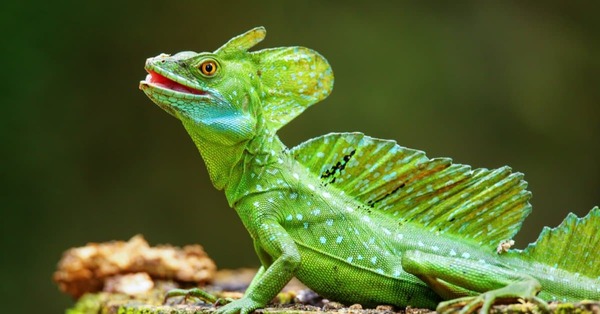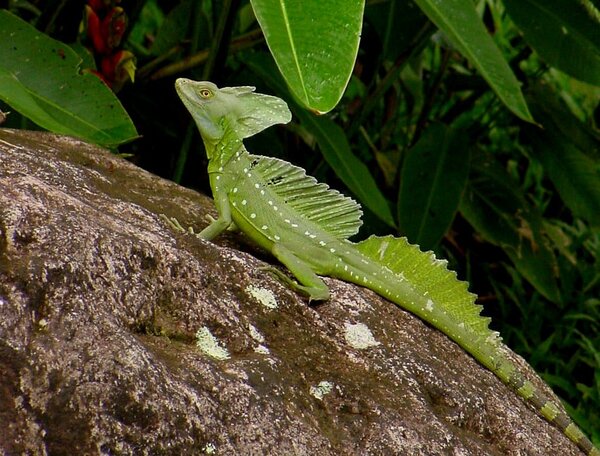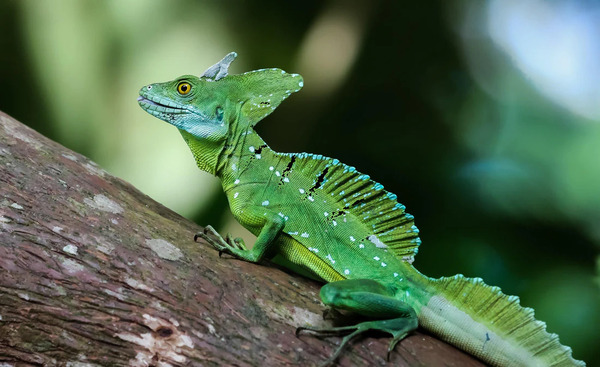If you've ever heard of a creature so fearsome that it could kill with just a glance, then you're familiar with one of the most fascinating legends of mythology: the basilisk. This mythical beast has appeared in folklore, literature, and popular media for centuries, captivating imaginations with its deadly gaze and powerful venom. So, what exactly is a basilisk, and how did it gain such an iconic status? Let’s dive into its origins, characteristics, and how it's portrayed in both ancient tales and modern stories.

The term “basilisk” originates from the Greek word basiliskos, meaning "little king." The creature’s name may seem harmless, but the basilisk is anything but. According to Greek and Roman mythology, the basilisk was a serpent of immense power and danger. The ancient natural historian Pliny the Elder described it as a small snake with the power to kill anything it encountered, either by its poisonous venom or by its lethal gaze. Unlike any ordinary snake, the basilisk was regarded as the "king of serpents" because of its unmatched strength and the terror it inspired.
Over time, the legend of the basilisk evolved. Medieval folklore added new traits, such as the idea that it was born from a rooster's egg incubated by a toad. This unique birth process only added to the creature's mysterious and unsettling nature. The basilisk became a symbol of dark magic and evil in European folklore, often associated with alchemy and sorcery.
The basilisk is traditionally depicted as a snake or serpent, but over the centuries, its appearance has varied. Here are some of the most commonly attributed traits of this mythical creature:
Deadly Gaze: Perhaps the basilisk’s most famous trait is its ability to kill with a single look. It is said that if the basilisk looked directly at a person or animal, they would instantly die or be turned to stone. This deadly stare makes the basilisk one of the most terrifying mythical creatures, giving it a unique place in legend.
Venomous Bite: Besides its gaze, the basilisk was known for its potent venom. Even a single drop of its venom was believed to be strong enough to kill anyone it touched and could poison entire water sources. Some stories say that if the basilisk’s venom touched a blade, it would melt the metal instantly.
Symbol of Death and Danger: Because of its deadly powers, the basilisk became a symbol of death in many cultures. In medieval literature, encountering a basilisk often represented a test of courage and wisdom.
Unique Creation: As mentioned, medieval myths state that the basilisk could only be born from a very rare event: a rooster laying an egg, which would then need to be incubated by a toad or serpent. This unusual origin story gave the basilisk a mystical and eerie aura, as it was both unnatural and highly unlikely.
Defeating the Basilisk: According to legend, there were specific ways to defeat a basilisk. One popular method involved using a mirror to reflect its deadly gaze back at it. Another suggested that only the odor of a weasel or the crowing of a rooster could kill it. These remedies became part of folklore, symbolizing that even the most powerful forces of evil had vulnerabilities.
The basilisk has appeared throughout literature, art, and media for centuries, constantly adapting with the times while retaining its fearsome reputation.
Literature: The basilisk is featured in classic works, including Geoffrey Chaucer’s Canterbury Tales and Shakespeare’s Richard III. In both cases, it serves as a metaphor for destructive power and deadly beauty.
Harry Potter Series: In modern times, Harry Potter and the Chamber of Secrets brought the basilisk back into the spotlight. J.K. Rowling’s version of the basilisk is a gigantic serpent that can kill with its stare. This version remains true to its mythological roots, showing both its dangerous gaze and venom.
Video Games: The basilisk has become a staple in fantasy video games like Dark Souls and The Witcher. In these games, the basilisk is usually depicted as a powerful serpent-like monster, often with the ability to paralyze or petrify its victims.
Role-Playing Games: In Dungeons & Dragons, the basilisk is a reptilian creature with a petrifying gaze, a trait players must be cautious of. This version has contributed to the basilisk’s status as a classic monster in fantasy lore.
The basilisk captures human imagination because it embodies both the mystery and terror associated with ancient myths. This creature combines the natural fear of venomous snakes with the supernatural horror of a deadly gaze. Its ability to petrify or kill instantly has made it a symbol of both beauty and danger, while its unique birth and vulnerability to mirrors add layers of intrigue. Over the centuries, the basilisk has evolved in storytelling, becoming not just a creature of legend but a metaphor for humanity's fear of the unknown.
In modern media, the basilisk continues to enchant audiences, serving as a reminder of the power of myth and imagination. Its timeless appeal lies in its embodiment of the supernatural and its role as a cautionary figure in stories about courage, wisdom, and the balance between good and evil.
The basilisk remains one of mythology’s most iconic creatures, representing deadly beauty and the power of the unknown. From ancient Greece to the fantasy worlds of today, it has left a lasting impression on culture, symbolizing both the dangers of unchecked power and the resilience of those who face their fears. Whether encountered in a medieval bestiary or on the pages of modern fantasy novels, the basilisk continues to captivate, reminding us of the enduring strength of ancient legends in a modern world.
This detailed look into the basilisk, from its origins to its role in contemporary culture, showcases why this mythical serpent has fascinated people for centuries.

The Plumed Basilisk (Basiliscus plumifrons), also known as the green basilisk or "Jesus Christ lizard," is one of nature's most fascinating reptiles. Known for its incredible ability to "walk on water," this Central American lizard has captivated the imaginations of scientists, nature enthusiasts, and viewers worldwide. In this article, we’ll explore the plumed basilisk’s unique features, habitat, behaviors, and the fascinating way it evades predators.
The plumed basilisk belongs to the Corytophanidae family, which includes other species of basilisk lizards. It is native to Central America, primarily found in countries like Costa Rica, Nicaragua, Honduras, and Panama. With a striking appearance and unique physical abilities, the plumed basilisk stands out as one of the most remarkable lizards on the planet.
Distinctive Appearance: The plumed basilisk is an eye-catching lizard with a vibrant green body and striking blue or white markings along its head, tail, and limbs. Males are especially recognizable due to the crests, or "plumes," that they sport on their heads, backs, and tails. These crests not only give the lizard its name but also make the males appear larger, which can be advantageous during courtship displays or when establishing territory.
Size: Plumed basilisks are medium-sized lizards that can grow up to 3 feet (about 0.9 meters) in length, including their long, whip-like tails. Females are usually smaller than males and lack the large crests, giving them a more streamlined appearance.
Adaptations for Running on Water: The plumed basilisk is famous for its ability to sprint across the surface of water, a feat that’s possible due to specialized flaps of skin on its toes. When the basilisk runs at high speed, these flaps open and create tiny air pockets, which allow it to stay atop the water momentarily. This incredible adaptation has earned the lizard its nickname, "Jesus Christ lizard."
Habitat: Plumed basilisks thrive in the tropical rainforests of Central America. They prefer habitats with abundant water sources like rivers, streams, and ponds, which are crucial to their survival. These lizards are semi-aquatic and spend much of their time near or even in water, as it provides both a habitat and a means of escape from predators.
Diet: As omnivores, plumed basilisks have a varied diet. They feed on insects, small fish, frogs, and fruits, which provide essential nutrients. This adaptable diet allows them to thrive in diverse environments and make the most of available resources. Young basilisks primarily eat insects to sustain their rapid growth, while adults incorporate more plant matter into their diet as they mature.
One of the most captivating behaviors of the plumed basilisk is its ability to run on water. When threatened by predators such as snakes, birds, or larger reptiles, the basilisk uses its powerful hind legs to sprint across the water’s surface, often covering a distance of 10 to 15 feet before it eventually sinks and starts swimming. This water-walking ability is not just a unique escape mechanism but also a stunning example of natural evolution.

The basilisk’s incredible feat is possible thanks to several factors:
Powerful Leg Muscles: Strong hind limbs propel the basilisk forward at high speeds, allowing it to create enough momentum to stay above water.
Long Toes and Skin Flaps: The basilisk's long toes spread out and create a larger surface area, while specialized skin flaps open as each foot strikes the water. These structures trap air and create buoyancy, briefly suspending the lizard on the surface.
High Speed: The faster the basilisk runs, the less it sinks into the water. To stay upright, the lizard must maintain a high speed—generally around 5 miles per hour.
Plumed basilisks have a straightforward but fascinating reproductive process:
Breeding Season: During the breeding season, males attract females through visual displays, often involving their large crests. They may also engage in aggressive behaviors to ward off competing males.
Egg Laying: Female basilisks lay clutches of 10 to 20 eggs in burrows they dig into the soft forest floor. After laying the eggs, the female covers them, leaving them to incubate on their own. Unlike many other reptiles, basilisk parents do not guard their eggs.
Hatchlings: After an incubation period of about two to three months, the eggs hatch, and young basilisks emerge. Hatchlings are fully independent from birth and are capable of sprinting on water almost immediately, an adaptation crucial for survival against predators.
Despite their agility and unique escape mechanisms, plumed basilisks are preyed upon by several predators. Larger reptiles, birds of prey, and mammals such as raccoons are natural threats to both young and adult basilisks. Their vibrant green color offers them camouflage within dense foliage, and when necessary, they dive underwater, where they can stay submerged for up to 30 minutes, evading detection.
In terms of conservation, plumed basilisks are not currently listed as endangered, although habitat loss due to deforestation does pose a risk to their populations. Preserving tropical rainforests is essential to maintaining healthy basilisk populations in the wild.

The plumed basilisk’s remarkable water-walking ability has made it a popular subject in documentaries, films, and nature photography. Its nickname, the "Jesus Christ lizard," has brought it widespread attention and fascination, even among people with no prior interest in reptiles. This unique characteristic has also fueled studies in biomechanics and animal locomotion, as scientists examine how adaptations like those of the basilisk could inspire human engineering.
The plumed basilisk is a captivating example of how animals adapt to survive in their environment. Its unique morphology and behaviors showcase nature’s ingenuity and the incredible survival strategies evolved over millions of years. With its water-walking skills, beautiful green coloration, and complex social behaviors, the plumed basilisk stands as a reminder of the diversity and wonder found in the world’s rainforests.
Whether you're a nature enthusiast, a biology student, or simply intrigued by unique animals, the plumed basilisk represents a fascinating chapter in the story of our planet's biodiversity.
animal tags: Basilisk
We created this article in conjunction with AI technology, then made sure it was fact-checked and edited by a Animals Top editor.